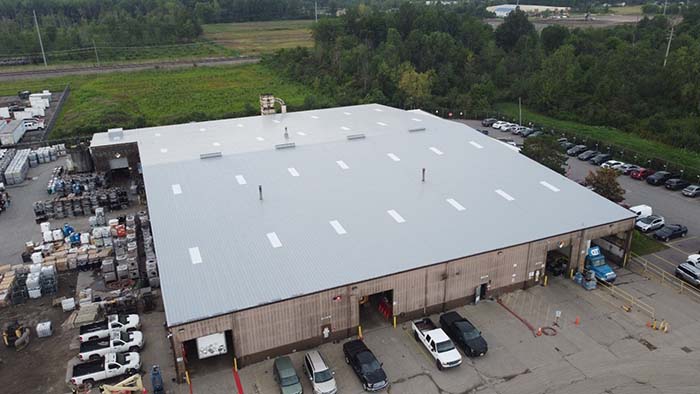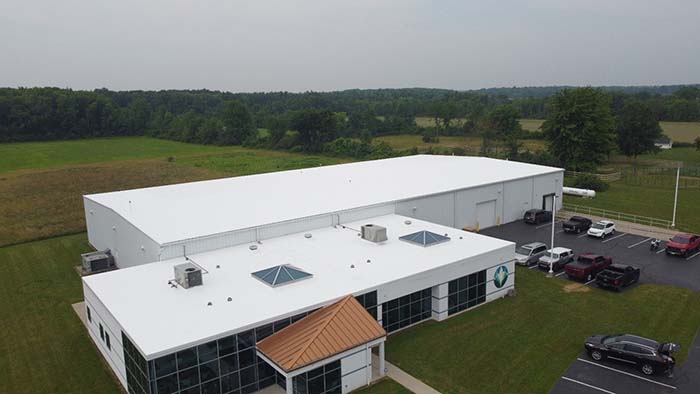The three requirements needed to install a roof coating system and get a manufacturer’s warranty are:
- The existing insulation must be less than 25% saturated
- Annual maintenance must have occurred
- Seams and flashings must be in decent condition
We’ll explain each of these points in more detail below.
And just so you’re aware, West Roofing Systems has been installing roof coating systems since they’ve been a standalone roofing system (around 2008). We specialize in spray foam roofing systems, which always use an elastomeric coating for UV protection. We’ve been using coatings since 1979.
Here’s what we’ll also cover in this article:
- An overview of the three requirements
- Why are building owners interested in roof coating systems?
- Does the type of existing roof matter?
- What does a building owner do if they don’t meet the requirements?

The three requirements
They basically all stem from annual maintenance. If the roof has been neglected for many years, the roof is probably in bad shape. It’ll most likely have seams in bad condition. And the roof’s insulation will likely be more than 25% saturated.
If there was annual maintenance, most likely when the seams began to lose adhesion, the repair is made to stop future saturation/leaking.
The same happens when a loose flashing, hole in the membrane, or any other type of minor repair allows water into the insulation. The issue is identified within a year and repaired.
When small issues remain unfixed for 5+ years, the insulation collects water, expands, and usually exceeds the 25% threshold.
Why are building owners interested in roof coating systems?
These are the main reasons:
- It eliminates the complete tear-off (huge cost savings versus a complete tear-off)
- It comes with a new 10-20-year warranty (the thickness of the coating determines the warranty length)
- The warranty is transferrable and renewable (once the warranty is over, clean the roof, install more coating, and a new warranty is granted)
- It increases reflectivity, which lowers the roof temp. This reduces energy bills and makes your HVAC units work less hard.

Does the existing roofing system matter?
It does.
A roof with a rough surface is most likely not a good candidate for a roof coating system.
A significant amount of coating will be required to make the roof surface smooth, and then more coating will need to be installed to grant a warranty.
A more cost-effective option is to install a spray foam roofing system.
A roof coating system can be installed cost-effectively over every other existing roof system (TPO, EPDM, Metal, SBUR, granulated modified, etc.)
What does a building owner do if they don’t meet the requirements?
There are a few factors here:
- The number of existing roofing systems already installed
- What the existing roofing system is
For example, say you have two roofing systems installed. Per code, you cannot install a 3rd roofing system, so, at a minimum, the 2nd roof would have to be removed entirely before installing a new roofing system.
If you have an EPDM/TPO roof with two roofing systems, you could rip all the EPDM/TPO off. Then identify, remove, and replace the wet insulation, then install any roofing system you choose.
If both roofing systems have excessive wet insulation, you’ll need to remove everything off the roof, except the remaining good insulation of the 1st roof. In this case, starting over is probably beneficial if there’s more than 30% saturation.
If you have a metal roof, you can flute-fill or install a new metal roof over the existing one. But the most cost-effective solution is to install spray foam over what you already have.
NOTE: When advised to do a complete tear-off without an explanation, this is a red flag. A contractor might be removing good insulation, then just putting new good insulation back on. Also, a manufacturer might tell the contractor they can only work on this roof if all the insulation is removed and replaced. Don’t fall for this. Get a good explanation as to why all the insulation has to be removed.

Conclusion
I hope we’ve clarified the requirements for a coating system. If you aren’t eligible, you have plenty of options to get your commercial roof right.
Here are some other pieces of content you might find helpful:
- Case Study: Oakview Elementary – Learn how a 20-year-old EPDM roof was “re-roofed” with spray polyurethane foam.
- Article – What Is the Ballpark Cost of a Spray Foam Roof per Square Foot?
- Article – 6 Problems Roof Coating Systems Have

